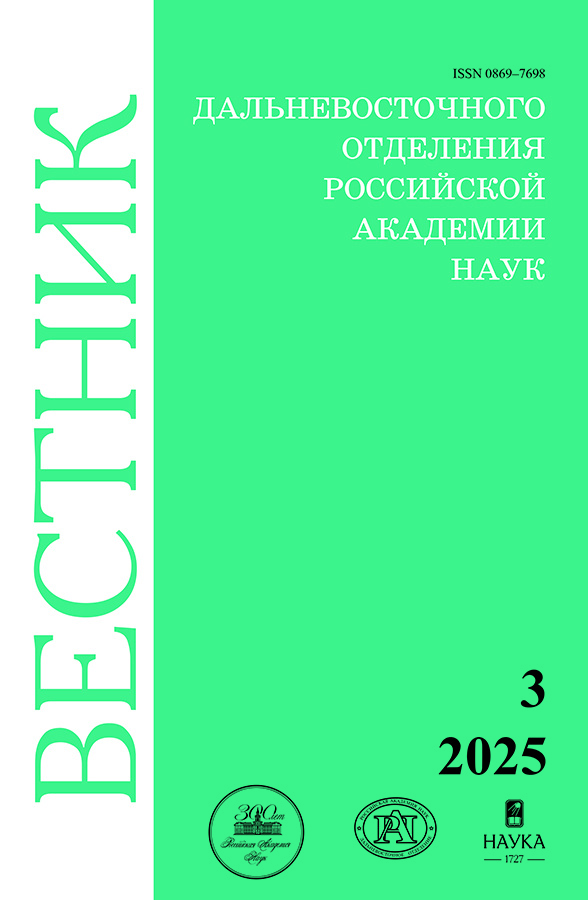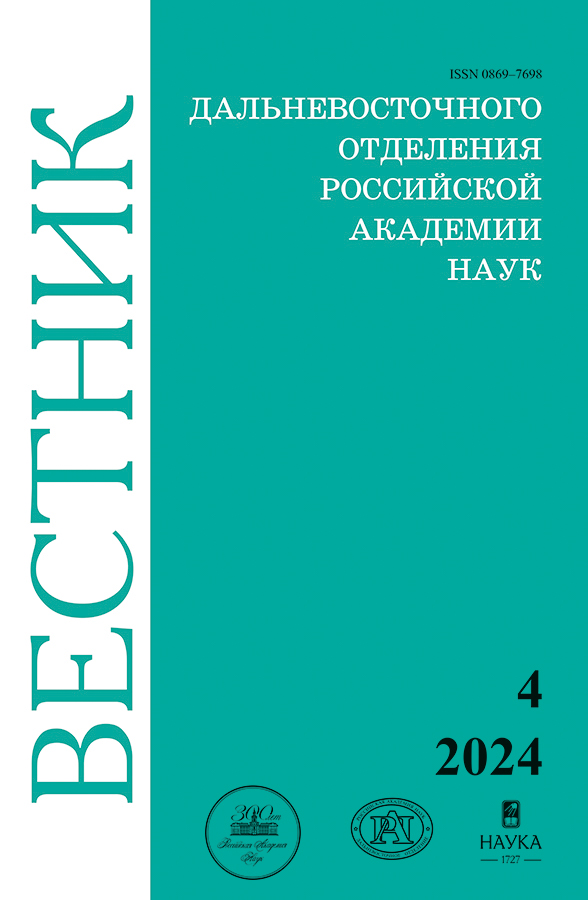The use of genetic material of wild relatives of Kamchatka honeysuckle (Lonicera caerulea var. kamtschatika Sevast.) in analytical breeding
- Authors: Petrusha E.N.1, Rusakova E.A.1
-
Affiliations:
- Kamchatka Scientific Research Institute of Agriculture – N. I. Vavilov All-Russian Institute of Plant Genetic Resources
- Issue: No 4 (2024)
- Pages: 126-133
- Section: Agricultural sciences. Crop science
- URL: https://permmedjournal.ru/0869-7698/article/view/676072
- DOI: https://doi.org/10.31857/S0869769824040103
- EDN: https://elibrary.ru/IQHXDG
- ID: 676072
Cite item
Full Text
Abstract
In the selection of blue honeysuckle, Kamchatka honeysuckle (Lonicera caerulea var. kamtschatika Sevast.) is a valuable donor of dessert taste, large-sized berries, and winter hardiness. Wild relatives of Kamchatka honeysuckle are of particular value in analytical selection due to wide polymorphism in wild populations of Kamchatka. The article summarizes information on the results of Kamchatka selection using honeysuckle forms selected from wild populations of the central and southern regions of the Kamchatka Territory. During the complex selection process, special attention was paid to economic-valuable and selection-significant traits: frost resistance, different ripening periods, high yield, early fruiting (for 3 years after planting), attractiveness, large-sized berries (more than 1.0 g), non-shattering, dessert taste, high sugar content, vitamin C, low acidity. As a result of the search and selection of wild forms of honeysuckle in breeding nurseries about 4,000 seedlings were studied, more than 50 forms were selected as an elite, and 6 varieties were obtained. Over 800 seedlings of planting 2020–2023 are in the study, new promising elite forms-varieties have been created: 1–5 (Malka), 1–20 (Vilyuyka), 31–35 (Ganalochka), characterized by high economically valuable characteristics. According to the results of the selection of seed material in 2023, the Kamchatka honeysuckle gene pool was replenished with 51 forms promising for breeding from various populations: 10 forms from the Elizovsky district, 20 forms from the Milkovsky district, 8 forms from the Ust-Kamchatsky district and 13 forms from the Bystrinsky district. For a more effective and high-quality output of promising selected forms for analytical breeding, it is necessary to continue transferring valuable sources from wild nature to culture and their comprehensive study.
Full Text
About the authors
Elena N. Petrusha
Kamchatka Scientific Research Institute of Agriculture – N. I. Vavilov All-Russian Institute of Plant Genetic Resources
Email: petrusha1960@inbox.ru
ORCID iD: 0009-0001-8442-8500
Senior Researcher
Russian Federation, Kamchatka Territory, Sosnovka vil.Elena A. Rusakova
Kamchatka Scientific Research Institute of Agriculture – N. I. Vavilov All-Russian Institute of Plant Genetic Resources
Author for correspondence.
Email: rubusarcticus@mail.ru
ORCID iD: 0009-0004-8480-5910
Junior Researcher
Russian Federation, Kamchatka Territory, Sosnovka vil.References
- Il’in V. S. Zhimolost’ sinjaja. Pomologija. V pjati tomah. Tom 5. Zemljanika. Malina. Orehoplodnye i redkie kul’tury= [Blue honeysuckle. Pomology. In five volumes. Vol. 5. Strawberries. Raspberries. Nutty and rare crops]. Orjol: Izd-vo VNIISPK; 2014. 587 p. (In Russ.).
- Sorokopudov V. N., Aleksandrov D. S. Zhimolost’: dekorativnaya i s”edobnaya = [Honeysuckle: decorative and edible]. Prospects for the implementation of scientific research results in the modern world: collection of articles of the International Scientific Conference, Tomsk, 2023, January, 21. St. Petersburg: Obshchestvo s ogranichennoi otvetstvennost’yu «Mezhdunarodnyi institut perspektivnykh issledovanii imeni Lomonosova»; 2023. S. 19–21. (In Russ.).
- Petrusha E. N. Otsenka iskhodnogo materiala zhimolosti kamchatskoi dlya selektsii na krupnoplodnost’ i kachestvo yagod = [Assessment of the source material of Kamchatka honeysuckle to breed for large-fruited berries with improved qualities]. Dal’nevostochnyi Agrarnyi Vestnik. 2020; 54(2):41–46. (In Russ.). doi: 10.24411/1999-6837-2020-12020.
- Sofronov A. P., Firsova S. V., Golovunin V. P. Zhimolost’ sinyaya (Lonicera caeruleae L.): tekhnologiya i selektsiya= [Blue honeysuckle (Lonicera caerulea L.): technology and breeding]. Kirov: FGBNU FANTs Severo-Vostoka; 2021. 64 p. (In Russ.)
- Kuklina A. G., Sorokopudov V. N., Upadyshev M. T. et al. Sostoyanie i perspektivy selektsii zhimolosti sinei = [The state and prospects of blue honeysuckle breeding].Vestnik RSKhN. 2017;(5):41–46. (In Russ.).
- Khokhryakova L. A. Perspektivy selektsii zhimolosti = [Prospects for honeysuckle breeding]. Modern directions of horticulture development in Siberia: collection of materials of the All-Russian Scientific and Practical Conference dedicated to the 95th anniversary of the birth of Academician of the Russian Academy of Sciences I. P. Kalinina. Barnaul: Azbuka; 2022. Р. 136–140. (In Russ.).
- Yakubov V. V., Chernyagina O. A. Katalog flory Kamchatki (sosudistye rasteniya) = [Catalog of Kamchatka flora (vascular plants)]. Petropavlovsk-Kamchatskii: Kamchatpress; 2004. 165 p. (In Russ.).
- Nechaev A. A. Vidovoi sostav i resursnye kharakteristiki dikorastushchikh s”edobnykh yagodnykh rastenii rossiiskogo Dal’nego Vostoka = [Wild edible honeysuckle in the far east: species composition, distribution, resources, reclamation]. Use and reproduction of forest resources in the Far East. Proceedings. Khabarovsk: Far Eastern Forestry Research Institute; 2016. Iss. 39. P. 105–125. (In Russ.).
- Eremin G. V., Dubravina I. V., Kovalenko N. N., Gasanova T. A. Predvaritel’naya selektsiya plodovykh kul’tur: monografiya = [Preliminary selection of fruit crops: monograph]. Krasnodar: KubGAU; 2015. 335 p. (In Russ.).
- Petrusha E. N., Rusakova E. A. Geneticheskoe raznoobrazie zhimolosti kamchatskoi kak istochnik selektsii na produktivnost’ i kachestvo plodov = [Genetic diversity of Kamchatka honeysuckle as a source of breeding for productivity and quality of berries]. Contemporary Horticulture.2023;(3):27–34. (In Russ.). doi: 10.52415/23126701_2023_0304.
Supplementary files









